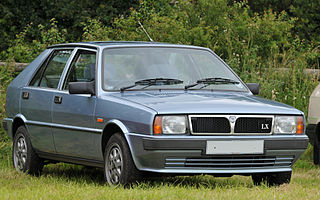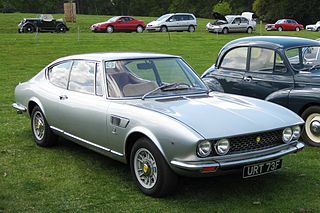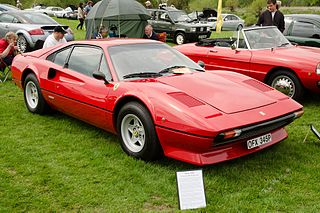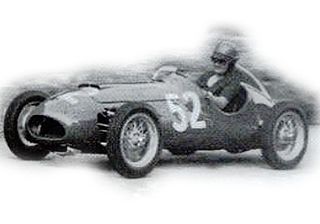
The Fiat 128 is a transverse front-engine, front wheel drive small family car manufactured and marketed by Fiat from 1969 to 1985 as a two- or four-door sedan, three- or five-door station wagon as well as two- or three-door coupé. The 128 running gear and engine, reconfigured for a mid-engined layout, were used in the Fiat X1/9 sports car.

The Lancia Delta is a small family car produced by Italian automobile manufacturer Lancia in three generations. The first generation (1979–1994) debuted at the 1979 Frankfurt Motor Show, the second generation (1993-1999) debuted at the 1993 Geneva Motor Show, and the third generation (2008–2014) debuted at 2008 Geneva Motor Show.

The Fiat X1/9 is an Italian two-seater mid-engined sports car designed by Bertone and manufactured by Fiat from 1972–1982 and subsequently by Gruppo Bertone from 1982–1989.

The Mitsubishi Lancer Evolution, popularly referred to as the 'Evo', is a sports sedan and rally car based on the Lancer that was manufactured by Japanese manufacturer Mitsubishi Motors from 1992 until 2016. There have been ten official versions to date, and the designation of each model is most commonly a Roman numeral. All generations use two-litre intercooled turbo inline four-cylinder engines and all-wheel drive systems.

The Fiat Dino was a front-engine, rear-wheel-drive sports car produced by Fiat from 1966 to 1973. The Dino name refers to the Ferrari Dino V6 engine, produced by Fiat and installed in the cars to achieve the production numbers sufficient for Ferrari to homologate the engine for Formula 2 racing.

The Ferrari 308 GTB berlinetta and targa-topped 308 GTS are V8 mid-engined, two-seater sports cars manufactured by the Italian company Ferrari from 1975 until 1985. The 308 replaced the Dino 246 GT and GTS in 1975 and was updated as the 328 GTB/GTS in 1985. The similar 208 GTB and GTS were equipped with a smaller, initially naturally aspirated and later turbocharged, two-litre engine, and were sold mainly in Italy.

The Fiat 131 is a mid-size family car manufactured and marketed by Fiat from 1974 to 1984 after its debut at the 1974 Turin Motor Show. Available as a two-door and four-door saloon and 5-door estate across a single generation, the 131 succeeded the Fiat 124.

The Lancia Rally was a mid-engine sports car and rally car built by Lancia in the early 1980s to compete in the FIA Group B World Rally Championship. Driven by Markku Alén, Attilio Bettega, and Walter Röhrl, the car won Lancia the manufacturers' world championship in the 1983 season. It was the last rear-wheel drive car to win the WRC.

The Fiat 124 Sport Coupé is a two-door, four-seater notchback coupé produced by the Italian automaker Fiat in three generations between 1967 and 1975. It was based on the Fiat 124 saloon.

The FSO Polonez is a motor vehicle that was developed in Poland in collaboration with Fiat and produced by Fabryka Samochodów Osobowych from 1978 to 2002. It was based on the Polski Fiat 125p platform with a new hatchback design by Zbigniew Watson, Walter de Silva and Giorgetto Giugiaro. It was available in body styles that included two- and four-door compact-sized cars, station wagons, as well as commercial versions as pickup truck, cargo van, and ambulance. Production totaled more than one million units, excluding the pickup truck and van variants. The Polonez was marketed in other nations and was popular in its domestic market until Poland joined the European Union in 2004.

The Fiat 124 Sport Spider is a convertible sports car marketed by Fiat for model years 1966–1985. Designed by and manufactured at the Italian carrozzeria Pininfarina factory, the monocoque, front-engined, rear-drive Sport Spider debuted at the November 1966 Turin Auto Show with styling by Tom Tjaarda.

The Fiat Argenta is a large family car produced by the Italian automobile company Fiat from 1981 to 1985. It was a comprehensive update of the Fiat 132 and the last mass-produced Fiat with rear-wheel drive until the 2016 124 Spider. The change to a name came about as Fiat was changing their naming strategy, changing from three-digit numbers to more meaningful names. This model was available in sedan/saloon bodystyle only.

Polski Fiat 125p is a motor vehicle manufactured between 1967 and 1991 in Poland under a Fiat license by the state-owned manufacturer Fabryka Samochodów Osobowych (FSO). It was a simplified and altered variation of the original, Italian-made Fiat 125, with engines and mechanicals from the Fiat 1300/1500. To distinguish between the models, Fiat and FSO revived the marque Polski Fiat. After termination of the license, the car was branded as FSO 1300, FSO 1500 and FSO 125p.
The following outline is provided as an overview of and topical guide to automobiles:

Devin Enterprises was an American automotive manufacturer that operated from 1955 to 1964. Devin was mainly known for producing high quality fiberglass car bodies that were sold as kits, but they also produced automotive accessories as well as complete automobiles. The company was founded by Bill Devin.

The third-generation Chevrolet Camaro is an American pony car which was introduced for the 1982 model year by Chevrolet. It continued to use General Motors' F-body platform and produced a "20th Anniversary Commemorative Edition" for 1987 and "25th Anniversary Heritage Edition" for 1992. These were also the first Camaros with factory fuel injection, four-speed automatic transmissions, five-speed manual transmissions, four-cylinder engines, 16-inch wheels, and hatchback bodies. For 1987 a convertible Camaro was reintroduced, converted by ASC in relatively small numbers. The third-generation Camaro continued through the 1992 model year.

The Bandini formula three is a racing car model produced from 1954 until 1958 by Bandini Automobili of Forlì.

The first generation Subaru Legacy is a mid-size family car / wagon developed by Fuji Heavy Industries. The Legacy was an all new model, and was considered a notable departure from Subaru products in the past.

The Alfa Romeo Scarabeo is a concept car engineered by Giuseppe Busso and Orazio Satta Puliga for Alfa Romeo with a body designed by Sergio Sartorelli at Officine Stampaggi Industriali. The car debuted at the Paris Motor Show in 1966.

The FSO Ogar LS is a Polish concept sports car developed in 1977 by FSO, using components from the Polski Fiat 125p.



















